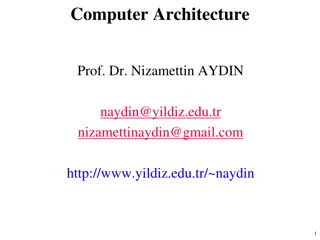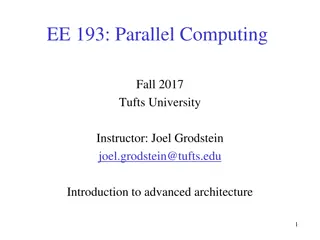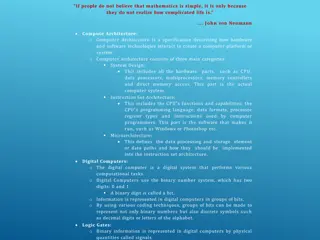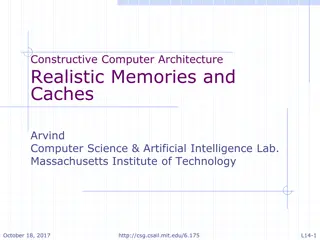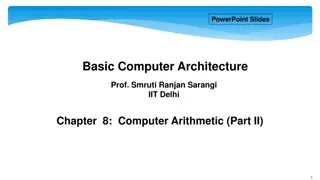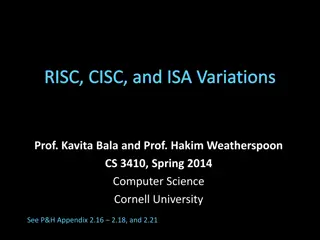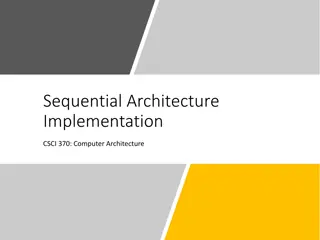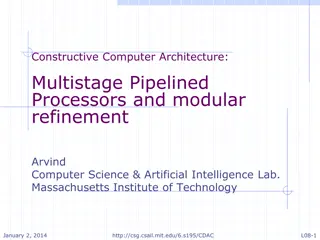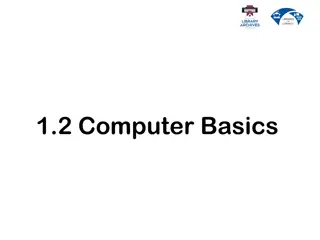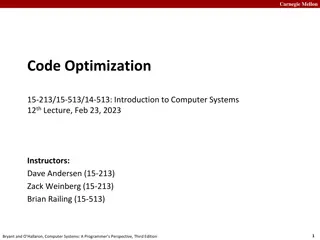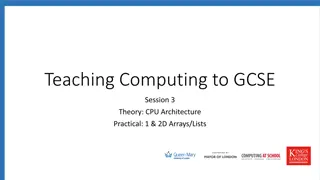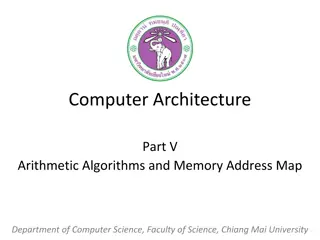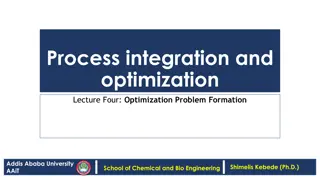Computer Architecture Basics: Recap of Key Concepts and Optimization Strategies
The lecture delved into hardware/software trade-offs, von Neumann vs. Harvard architecture differences, and explored the Von Neumann Computing Model. It also covered optimizing Harvard architecture, code restructuring for efficient execution, and discussed Amdahl's Law in relation to execution time breakdown and speedup calculations.
Download Presentation

Please find below an Image/Link to download the presentation.
The content on the website is provided AS IS for your information and personal use only. It may not be sold, licensed, or shared on other websites without obtaining consent from the author. Download presentation by click this link. If you encounter any issues during the download, it is possible that the publisher has removed the file from their server.
E N D
Presentation Transcript
Fall2023 Lecture 3: Computer Architecture Basics Credit: Brandon Lucia
What did we talk about last time? Hardware vs. software tradeoffs von Neumann vs. Harvard architecture and the beginnings of a design space An optimization exercise by example Amdahl s Law (and Gustafson s Law, by contrast)
Our first hw/sw interface: The Von Neumann Computing Model CPU Control & Instruction Sequencing ( Control ) John von Neumann s Big Idea: Programs are data. Arithmetic, Logic, and Data Manipulation ( ALU ) Unified Bus Memory Data Program
Optimizing our Harvard Architecture CPU 64bits Control & Instruction Sequencing ( Control ) 32bits I1: x = y + z I2: a = b * c I3: r = s + t Arithmetic, Logic, and Data Manipulation ( ALU ) Dual-ported Data Bus (2x64-bit read, 64-bit write port) Instruction Bus (32-bit read) With a one word (8 byte) bus: 1 data write cycle simultaneous with 1 data read cycles simultaneous with 1 instruction read cycle per arithmetic operation Memory Data Program 1 cycle per instruction!
How about changing the code? I1: I2: I3: I4: if (x==0) a = b * 2 y = z + w q = n + m y = z + w q = n + m if (x==0) a = b * 2 //else a = b * 4 //other //stuff I1: I2: I3: I4: I5: I6: I7: I8: CPU Control & Instruction Sequencing ( Control ) Compiler! I5: //else I6: a = b * 4 I7: y = z + w I8: q = n + m Arithmetic, Logic, and Data Manipulation ( ALU ) Dual-ported Data Bus (2x64-bit read, 64-bit write port) Instruction Bus (128-bit read) Restructure code, increase likelihood to execute Avoid needless fetch of non-executing code Q: What if x is most often non-zero? Memory Data Program
Amdahls Law 100% of execution time 45% - Memory Accesses 20% - Control Flow 17.5% - Integer 12.5% - Fetch Amdahl s Law: optimized time = [ 1-p x time / 1.0 ] + [ p x time / speedup ] Or equivalently: speedup = 1 / [ (1 p) / 1.0 + p / speedup ] 5% - Floating Point
optimizable part (p) Amdahl s Law Speedup >100x optimized part speedup? 80% optimizable? max speedup 5x! Optimized speedup for optimizable part
Another view of the world: Gustaffsons Law 100% of execution energy Integer Memory Accesses Floating Point Fetch Control Flow Idea: find an optimizable part of your system and make it bigger If we know that memory is optimizable, why not optimize more and do more memory accesses?
Another view of the world: Gustafsons Law Gustafson s Law: Sequential part does not grow as optimizable part grows. Can always add more optimizable part and make sequential part matter less Assume that we can scale up # of parallel mem operations, N Assume that we can scale input to use all N parallel memops data_size = 10 data[data_size] = { } if( ){ } //18 more of these conditionals if( ){ } data_size = 100000 data[data_size] = { } if( ){ } //18 more of these conditionals if( ){ } #parallel[N=1000] for d in 0..data_size{ d++ } Gustaffson! for d in 0..data_size{ d++ }
Another view of the world: Gustafsons Law 85% - Memory Accesses Gustafson s Law for overall speedup with speedup factor of N: (assume) Optimized time = T = 1 Unoptimized time = T = (1-p)T + pT*N = (1-p) + pN Scaled Speedup = T / T = (1-p) + pN
Another view of the world: Gustafsons Law Scale parallel memory accesses, N, up to 1000? Scaled Speedup = 1-p + 1000p = 999p + 1 Scaled Speedup = 999 * 0.85 + 1 = 850x 85% - Memory Accesses Gustafson s Law for overall speedup with speedup factor of N: (assume) Optimized time = T = 1 Unoptimized time = T = (1-p)T + pT*N = (1-p) + pN Scaled Speedup = T / T = (1-p) + pN
What is a Computer Architecture? Building up to our first architecture Defining the ISA: Architecture vs. Microarchitecture RISC vs. CISC ISAs RISCV ISA
Our CPU from last time is incomplete CPU Control & Instruction Sequencing ( Control ) Arithmetic, Logic, and Data Manipulation ( ALU ) What s missing?
Basic Architecture: State + processing elements state ALU/processing Maintain State (sequential logic) Process (combinational logic) control
Building up to our first architecture: ALU Input A Input B Opcode selector op = [+, -, x, /] ALU Output: A op B
Building up to our first architecture: ALU Input A Input B Opcode selector op = [+, -, x, /] ALU Output: A op B Design choice what operations do we support here?
Basic Architecture: State + processing elements state ALU/processing Input B Output: A op B Maintain State (sequential logic) ALU Input A Opcode selector op = [+, -, x, /] control
Basic Architecture: State + processing elements state ALU/processing Input B Register File Reg 1 Reg 2 Reg 3 Reg 4 Output: A op B ALU Input A Opcode selector op = [+, -, x, /] control
Building up to our first architecture: ALU + Registers Input A Register Control Input B Register Control Input A register select Input B register select Register File Reg 1 Reg 2 Reg 3 Reg 4 Input A Input B Opcode select op = [+, -, x, /] ALU Output C Output register select Output Register Control
Building up to our first architecture: ALU + Registers Input A Register Control Input B Register Control Input A register select Input B register select Register File Reg 1 Reg 2 Reg 3 Reg 4 Input A Input B Opcode select op = [+, -, x, /] ALU Output C Output register select Output Register Control Stateful Elements plus control required to access them, providing inputs to operations and storing outputs of operations
Building up to our first architecture: ALU + Registers Input A Register Control Input B Register Control Input A register select Input B register select Need to activate control logic to select right register for a particular operation. How? Register File Reg 1 Reg 2 Reg 3 Reg 4 Input A Input B Opcode select op = [+, -, x, /] ALU Output C Output register select Output Register Control Registers are named & explicit. Implication of explicit names? Design choice how many stateful elements / registers do we support?
Building up to our first architecture: Control Input A Register Control + Input B Register Control 4 Instruction Decode Instruction Fetch In A reg select In B reg select Register File Program Counter(PC) Reg 1 Reg 2 Reg 3 Reg 4 Input A Input B Op select ALU Instruction Memory Output C Out reg select Output Register Control Instruction gets decoded into signals that control the other parts of the system (more on encoding / decoding in a few slides)
Building up to our first architecture: Control Input A Register Control + Input B Register Control 4 Instruction Decode Instruction Fetch In A reg select In B reg select Register File Program Counter(PC) Reg 1 Reg 2 Reg 3 Reg 4 Input A Input B Op select ALU Instruction Memory Output C Out reg select Output Register Control Instruction memory holds all of the bits of all of the instructions that we might ever use to control other units. Design choice: Need to think about where we put this memory (and its hierarchy of caches)
Building up to our first architecture: Control Input A Register Control + Input B Register Control 4 Instruction Decode Instruction Fetch In A reg select In B reg select Register File Program Counter(PC) Reg 1 Reg 2 Reg 3 Reg 4 Input A Input B Op select ALU Instruction Memory Output C Out reg select Output Register Control Instruction fetch logic refers to PC, loads instruction from instruction memory and sends to decode. Design choices: how much to fetch at once? What to fetch next (not always obvious)?
Building up to our first architecture: Control Input A Register Control + Input B Register Control 4 Instruction Decode Instruction Fetch In A reg select In B reg select Register File Program Counter(PC) Reg 1 Reg 2 Reg 3 Reg 4 Input A Input B Op select ALU Instruction Memory Output C Out reg select Output Register Control Remember our fetch optimization from last time? That would go here. Specialized instruction memory access logic. (Physical memory may be the same, though)
Building up to our first architecture: Control Input A Register Control + Input B Register Control 4 Instruction Decode Instruction Fetch In A reg select In B reg select Register File Program Counter(PC) Reg 1 Reg 2 Reg 3 Reg 4 Input A Input B Op select ALU Instruction Memory Output C Out reg select Output Register Control Sequential Control: Each cycle, update the PC by adding 4. Implication for software of our current design?
Building up to our first architecture: Control Decoding a fetched operation breaks it from a blob of bits into a set of signals that we can use to configure the rest of the units in this diagram Input A Register Control + Input B Register Control 4 Instruction Decode Instruction Fetch In A reg select In B reg select Register File Program Counter(PC) Reg 1 Reg 2 Reg 3 Reg 4 Input A Input B Op select ALU Instruction Memory Output C Out reg select Output Register Control Key Idea: What we encode here has implications for other units and software layers above the instruction definition level. Mechanism of decoding and content of encoded/decoded instructions are orthogonal concepts. How? vs what?.
Building up to our first architecture: Memory Input A Register Control + Input B Register Control 4 Instruction Decode Instruction Fetch In A reg select In B reg select Register File Program Counter(PC) Reg 1 Reg 2 Reg 3 Reg 1 Reg 2 Reg 3 Reg 4 Reg 4 Input A Input B Output Register Control Op select op = [+, -, x, /] ALU Instruction Memory ALU: output C Out reg select ld: data Memory Memory Unit Unit Op select op = [ld,st] st: data ld/st: address Data Data Memory Memory
Building up to our first architecture: Memory Input A Register Control + Input B Register Control 4 Instruction Decode Instruction Fetch In A reg select In B reg select Register File Program Counter(PC) Reg 1 Reg 2 Reg 3 Reg 4 Input A Input B Output Register Control Op select op = [+, -, x, /] ALU Instruction Memory ALU: output C Out reg select ld: data Memory Unit Op select op = [ld,st] st: data ld/st: address Decoded instruction now needs to select: ALU op or Mem op? Data Memory
Building up to our first architecture: Memory Input A Register Control + Input B Register Control 4 Instruction Decode Instruction Fetch In A reg select In B reg select Register File Program Counter(PC) Reg 1 Reg 2 Reg 3 Reg 4 Input A Input B Output Register Control Op select op = [+, -, x, /] ALU Instruction Memory ALU: output C Out reg select ld: data Memory Unit Op select op = [ld,st] st: data ld/st: address Data Memory Here: address assumed to come from register directly
Building up to our first architecture: Memory Input A Register Control + Input B Register Control 4 Instruction Decode Instruction Fetch In A reg select In B reg select Register File Program Counter(PC) Address mode bits from decoded instruction Reg 1 Reg 2 Reg 3 Reg 4 Input A Input B Output Register Control Op select op = [+, -, x, /] ALU Instruction Memory ALU: output C Out reg select ld: data Memory Unit Op select op = [ld,st] st: data Address bits from register ld/st: address Data Memory Reality: ALU may crunch reg vals to generate address
Building up to our first architecture: Memory Input A Register Control + Input B Register Control 4 Instruction Decode Instruction Fetch In A reg select In B reg select Register File Program Counter(PC) Address mode bits from decoded instruction Reg 1 Reg 2 Reg 3 Reg 4 Input A Input B Output Register Control Op select op = [+, -, x, /] ALU Instruction Memory ALU: output C Out reg select ld: data Memory Unit Op select op = [ld,st] st: data Address bits from register ld/st: address Design choice: How many ways do we have to compute an address? How many ways should we have? Guess at implications of more ways? Data Memory
Building up to our first architecture: Memory Input A Register Control + Input B Register Control 4 Instruction Decode Instruction Fetch In A reg select In B reg select Register File Program Counter(PC) Reg 1 Reg 2 Reg 3 Reg 4 Input A Input B Output Register Control Op select op = [+, -, x, /] ALU Instruction Memory ALU: output C Out reg select ld: data Memory Unit Op select op = [ld,st] st: data ld/st: address Data Memory state
Building up to our first architecture: Memory Input A Register Control + Input B Register Control 4 Instruction Decode Instruction Fetch In A reg select In B reg select Register File Program Counter(PC) Reg 1 Reg 2 Reg 3 Reg 4 Input A Input B Output Register Control Op select op = [+, -, x, /] ALU Instruction Memory ALU: output C Out reg select ld: data Memory Unit Op select op = [ld,st] st: data ld/st: address Data Memory Are register files and memory two varieties of the same basic thing?
Building up to our first architecture: Branching PC+4 Input A Register Control + Input B Register Control 4 Instruction Decode Instruction Fetch In A reg select In B reg select + MUX Register File Program Counter(PC) Reg 1 Reg 2 Reg 3 Reg 4 PC Source Select Input A Input B Output Register Control Op select op = [+, -, x, /] Instruction Memory ALU ALU: output C Out reg select ld: data Memory Unit Branch Target Address Offset Op select op = [ld,st] st: data ld/st: address Data Memory
Building up to our first architecture: Branching PC+4 Input A Register Control + Input B Register Control 4 Instruction Decode PC Instruction Fetch In A reg select If PC Source Select not asserted PC=PC+4 Memory Program In B reg select + MUX Register File Reg 1 Reg 2 Reg 3 Reg 4 Program Counter(PC) Input A Input B PC Source Select Output Register Control If PC Source Select asserted PC=PC+off Op select op = [+, -, x, /] Instruction Memory ALU ALU: output C Out reg select Memory Unit ld: data Op select op = [ld,st] Branch Target Address Offset st: data ld/st: address Data Memory
Building up to our first architecture: Branching PC+4 Input A Register Control + Input B Register Control 4 Instruction Decode Instruction Fetch In A reg select In B reg select + MUX Register File Program Counter(PC) Reg 1 Reg 2 Reg 3 Reg 4 PC Source Select Input A Input B Output Register Control Op select op = [+, -, x, /] Instruction Memory ALU ALU: output C Out reg select ld: data Memory Unit Branch Target Address Offset Op select op = [ld,st] st: data ld/st: address Data Memory Where does our branch target offset originate? Alternative design choices? How are each of those used in code?
Building up to our first architecture: Branching PC+4 Input A Register Control + Input B Register Control 4 Instruction Decode Instruction Fetch In A reg select In B reg select + MUX Register File Program Counter(PC) Reg 1 Reg 2 Reg 3 Reg 4 PC Source Select Input A Input B Output Register Control Op select op = [+, -, x, /] Instruction Memory ALU ALU: output C Out reg select ld: data Memory Unit Branch Target Address Offset Op select op = [ld,st] st: data ld/st: address Data Memory How do we decide taken vs. not taken via PC Source Select?
Building up to our first architecture: Branching PC+4 Input A Register Control + Input B Register Control 4 Instruction Decode Instruction Fetch In A reg select In B reg select + MUX Register File Program Counter(PC) Reg 1 Reg 2 Reg 3 Reg 4 Input A Input B Output Register Control Op select op = [+, -, x, /] Instruction Memory ALU ALU: output C Out reg select Branch: PC Source Select ld: data Memory Unit Branch Target Address Offset Op select op = [ld,st] st: data ld/st: address Design Choice: ALU output determines PC source select when branch condition evaluates Alternative Design? Data Memory
A Complete (but slightly messy) RISCV-ish Datapath PC+4 Input A Register Control + Input B Register Control 4 Instruction Decode Instruction Fetch In A reg select In B reg select + MUX Register File Program Counter(PC) Reg 1 Reg 2 Reg 3 Reg 4 Input A Input B Output Register Control Op select op = [+, -, x, /] Instruction Memory ALU ALU: output C Out reg select Branch: PC Source Select ld: data Memory Unit Branch Target Address Offset Op select op = [ld,st] st: data ld/st: address Data Memory
A single-cycle design Clock PC+4 Input A Register Control + Input B Register Control 4 Instruction Decode Instruction Fetch In A reg select In B reg select + MUX Register File Program Counter(PC) Reg 1 Reg 2 Reg 3 Reg 4 Input A Input B Output Register Control Op select op = [+, -, x, /] Instruction Memory ALU ALU: output C Out reg select Branch: PC Source Select ld: data Memory Unit Branch Target Address Offset Op select op = [ld,st] st: data ld/st: address Data Memory
A single-cycle design Clock PC+4 Input A Register Control + Input B Register Control 4 Instruction Decode Instruction Fetch In A reg select In B reg select + MUX Register File Program Counter(PC) Reg 1 Reg 2 Reg 3 Reg 4 Input A Input B Output Register Control Op select op = [+, -, x, /] Instruction Memory ALU ALU: output C Out reg select Branch: PC Source Select ld: data Memory Unit Branch Target Address Offset Op select op = [ld,st] st: data ld/st: address Key Idea: Single-cycle design goes from reading an instruction out of memory all the way to writing results back to registers before the next clock edge. Data Memory
Thinking about latency: ALU Operations PC+4 Input A Register Control + Input B Register Control 4 Instruction Decode Instruction Fetch In A reg select In B reg select + MUX Register File Program Counter(PC) Address mode bits from decoded instruction Reg 1 Reg 2 Reg 3 Reg 4 Input A Input B Output Register Control Op select op = [+, -, x, /] ALU Instruction Memory ALU: output C Out reg select Branch: PC Source Select ld: data Memory Unit Branch Target Address Offset Op select op = [ld,st] st: data Address bits from register ld/st: address ALU Operation Latency: Circuit delay of ALU operations is (mostly) low. Why? Data Memory
Thinking about latency: ALU Operations PC+4 Input A Register Control + Input B Register Control 4 Instruction Decode Instruction Fetch In A reg select In B reg select + MUX Register File Program Counter(PC) Address mode bits from decoded instruction Reg 1 Reg 2 Reg 3 Reg 4 Input A Input B Output Register Control Op select op = [+, -, x, /] ALU Instruction Memory ALU: output C Out reg select Branch: PC Source Select ld: data Memory Unit Branch Target Address Offset Op select op = [ld,st] st: data Address bits from register ld/st: address ALU Operation Latency: Circuit delay of ALU operations is (mostly) low. Sum of delay of 5 or 6 units depending on impl. Need to fetch, decode, register access (in 1), reg access (in 2), ALU function, register writeback Data Memory
Thinking about latency: Memory PC+4 Input A Register Control + Input B Register Control 4 Instruction Decode Instruction Fetch In A reg select In B reg select + MUX Register File Program Counter(PC) Address mode bits from decoded instruction Reg 1 Reg 2 Reg 3 Reg 4 Input A Input B Output Register Control Op select op = [+, -, x, /] ALU Instruction Memory ALU: output C Out reg select Branch: PC Source Select ld: data Memory Unit Branch Target Address Offset Op select op = [ld,st] st: data Address bits from register ld/st: address Memory Latency: Memory accesses are pretty slow. Why? Data Memory
Thinking about latency: Memory PC+4 Input A Register Control + Input B Register Control 4 Instruction Decode Instruction Fetch In A reg select In B reg select + MUX Register File Program Counter(PC) Address mode bits from decoded instruction Reg 1 Reg 2 Reg 3 Reg 4 Input A Input B Output Register Control Op select op = [+, -, x, /] ALU Instruction Memory ALU: output C Out reg select Branch: PC Source Select ld: data Memory Unit Branch Target Address Offset Memory Latency Critical Path: Memory accesses are pretty slow in our datapath. Op select op = [ld,st] st: data Address bits from register ld/st: address Data Memory Sum of delay of 7 or 8 units depending on counting Need to fetch, decode, register access (addr part 1), reg access (addr part 2), alu (addr gen), memory unit, memory bank, register write
Implication of operation latencies? Single-cycle design means that the cycle time for the system is defined by the latency of the longest-latency operation In our case, that would be the memory latency (and ALU latency has some slack from the cycle time) If every operation is not a memory operation, then we have over- provisioned the cycle time of the system
Where is the HW/SW Interface in the Datapath? PC+4 Input A Register Control + Input B Register Control 4 Instruction Decode Instruction Fetch In A reg select In B reg select + MUX Register File Program Counter(PC) Reg 1 Reg 2 Reg 3 Reg 4 Input A Input B Output Register Control Op select op = [+, -, x, /] Instruction Memory ALU ALU: output C Out reg select Branch: PC Source Select ld: data Memory Unit Branch Target Address Offset Op select op = [ld,st] st: data ld/st: address Data Memory
Where is the HW/SW Interface? This is where software begins! PC+4 Input A Register Control + Input B Register Control 4 Instruction Decode Instruction Fetch In A reg select In B reg select + MUX Register File Program Counter(PC) Reg 1 Reg 2 Reg 3 Reg 4 Input A Input B Output Register Control Op select op = [+, -, x, /] Instruction Memory ALU ALU: output C Out reg select Branch: PC Source Select ld: data Memory Unit Branch Target Address Offset Op select op = [ld,st] st: data ld/st: address Data Memory















